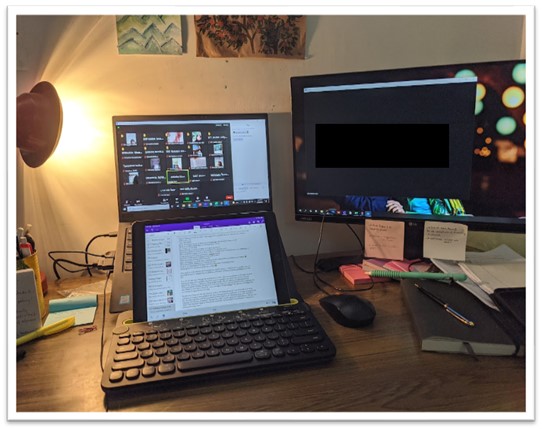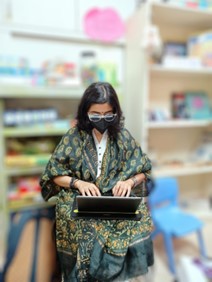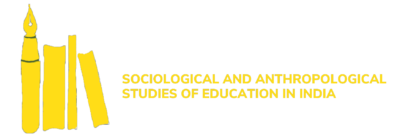Doing school-based research in a global pandemic
Dr. Tanushree Sarkar,
Post-doctoral fellow, Department of Educational Leadership and Policy Analysis, University of Missouri
In March 2021, I fulfilled all the requirements of my doctoral program in the United States to be able to begin school-based ethnographic fieldwork to study inclusive education policies and pedagogies in India. It was about a year into the COVID-19 pandemic; the worst seemed to be behind us. The intense lockdown had lifted, and schools showed signs of reopening. My dissertation proposal, written through the first three years of my doctoral degree, was developed as an in-depth, onsite participatory action research project. I planned to observe classrooms, interview teachers, hang out in the staffroom, and conduct workshops with teachers. I envisioned developing deep relationships of trust with teachers, schools, and non-governmental organizations through which we would collectively design a framework for inclusive pedagogy in the Indian context. Instead, that summer, India faced the deadly second wave of the pandemic – everyone knew someone who lost someone. In the aftermath of the second wave, in the midst of grieving, research seemed futile. Onsite fieldwork at a time when schools had been closed for almost 600 days, seemed impossible. Nevertheless, doctoral deadlines were ticking, funding was precarious, and the visa situation was tense. And so I had to, as was the lingo of the time, “pivot.”

The image above is from slides I created at the time to undertake this pivot. I reached out to members of my dissertation committee and scholars in the field to figure out how I could retain the essence of my research idea in the rapidly changing context of the global pandemic. In this article, I will focus on three considerations as I tried to navigate the challenges of doing research in a global pandemic. I describe these considerations almost as principles I engaged with, held on to, and struggled with through eight months of data gathering.
Incidentally, the first principle I held on to was letting go. I had to not only let go of my perfectly planned research proposal and design but also let go of the standard of ethnographic fieldwork wherein the researcher lives in the field, away from home, for prolonged periods as the primary means of knowing the Other. During this time, I found patchwork ethnography as a movement that challenged these assumptions about ethnographic fieldwork (Günel et al., 2020). Patchwork ethnography questions the traditional distinctions between home and the field in ethnographic research. Instead, the approach emphasizes flexibility and short-term data gathering, balancing rigor with care.
Fieldwork during the pandemic was dictated by the demands of the home, the field, the vagaries of state restrictions, vaccination schedules, and orders to shut and re-open schools. This made comparisons across sites in my multi-sited ethnographic work challenging. Research was almost entirely online at one site, and at another, research was largely conducted on-site. This raises critical questions about the claims I make about the classroom, school processes, and school-NGO relationships. There is no easy resolution here. Yet, the fractured, fragmented data allowed me to test assumptions, examine causality, and revel in variability (Tavory & Timmermans, 2013). For instance, I arrived at time as a central lens to analyze my data because of the similarities and distinctions in the temporal arrangements on Zoom and onsite classroom spaces. I started to wonder why there was an omnipresent sense of urgency and a need for speed across the two spaces.
The second key principle was drawn from inclusive and participatory research (Nind, 2014). Inclusive research views research as a collaborative process between the researcher and the researcher. I adopted methods to enable participation for all teachers interested in the study. As the participants and I were working women balancing the responsibilities of work and home, finding the time and space to conduct and participate in interviews was a key challenge to navigate. I ensured that teachers had the option of being interviewed over Zoom, over the telephone, or even through WhatsApp chats and voice notes. Teachers could choose when they wanted to be interviewed – and most decided to be interviewed at night, usually after dinner or before the evening tea when they had some time to themselves. Yet, the flexibility in forms of participation made classroom observations a particularly challenging endeavor. Crucially, Zoom-based classroom observations restricted my ability to capture the experiences of children in the classroom. The platform restricts how many videos can be viewed on one screen, which made it challenging to observe the large class sizes that characterized my field sites. While I could monitor the Zoom chat and the reactions students shared, it is important to recognize this limitation of school-based research during the pandemic. Even during on-site observations, the rapid changes in school timetables and the abrupt school closures meant that there was never a time that the school functioned in a way that it would function outside of a pandemic. Schools ran in shifts, followed half-day timetables, shut down for a week or two, often with little notice. In this setting, enabling participation for schools and teachers required steady collaboration and open communication between the researcher, the school leaders, and the teachers.

The third principle I followed in doing research in a global pandemic was enacting remote embeddedness (Howlett, 2021), that is, to develop ways to participate in the everyday life of the school and the teachers from a distance. I participated in online and in-person school meetings through Zoom, conducted teacher workshops on Google Classroom, and engaged with the school as a member of different WhatsApp groups.
Yet, the fluctuations in remoteness and closeness to onsite research highlighted the embodied dynamics of research. As a disabled researcher, I was deeply cautious of how my own disabled body operates in a project where I was interested in teachers’ views about disability and inclusive education (Barton, 2005; Tregaskis, 2004; Tregaskis & Goodley, 2005). Participants whose first interaction with me was through a screen did not have the opportunity to observe my disabled body in space. Disclosure of my disability identity raised several ethical and methodological dilemmas. On the other hand, participants who first met me onsite could ask questions about my disability, and observe differences in my body even before I recruited them as participants. Thus, while remote embeddedness was an invitation into teachers’ homes and families, it raises important questions about the embodied aspects of carrying out ethnographic research.

In thinking through these principles, I highlight the challenges and dilemmas associated with carrying out research during a global pandemic – a time of immense fear, economic precarity, and medical and emotional uncertainty. Doing research in such circumstances called for restraint and refusal, to determine which aspects of my methodological training and rigor to hold on to and what to let go of. Importantly, it reaffirmed the central ethic of prioritizing participants’ needs, and safety and valuing their full humanity.
References
Barton, L. (2005). Emancipatory research and disabled people: Some observations and questions. Educational Review, 57(3), 317–327. https://doi.org/10.1080/00131910500149325
Günel, G., Varma, S., & Watanabe, C. (2020, June 9). A Manifesto for Patchwork Ethnography. Member Voices, Fieldsights. https://culanth.org/fieldsights/a-manifesto-for-patchwork-ethnography
Howlett, M. (2021). Looking at the ‘field’ through a Zoom lens: Methodological reflections on conducting online research during a global pandemic. Qualitative Research. https://doi.org/10.1177/1468794120985691
Nind, M. (2014). Inclusive research and inclusive education: Why connecting them makes sense for teachers’ and learners’ democratic development of education. Cambridge Journal of Education, 44(4), 525–540. https://doi.org/10.1080/0305764X.2014.936825
Tavory, I., & Timmermans, S. (2013). A pragmatist approach to causality in ethnography. American Journal of Sociology, 119(3 (November 2013)), 682–714. https://doi.org/10.1086/675891
Tregaskis, C. (2004). Identity, Positionality and Power: Issues for Disabled Researchers. A Response Paper to Broun and Heshusius. Disability Studies Quarterly, 24(2). https://doi.org/10.1017/CBO9781107415324.004
Tregaskis, C., & Goodley, D. (2005). Disability research by disabled and non-disabled people: Towards a relational methodology of research production. International Journal of Social Research Methodology: Theory and Practice, 8(5), 363–374. https://doi.org/10.1080/13645570500402439
